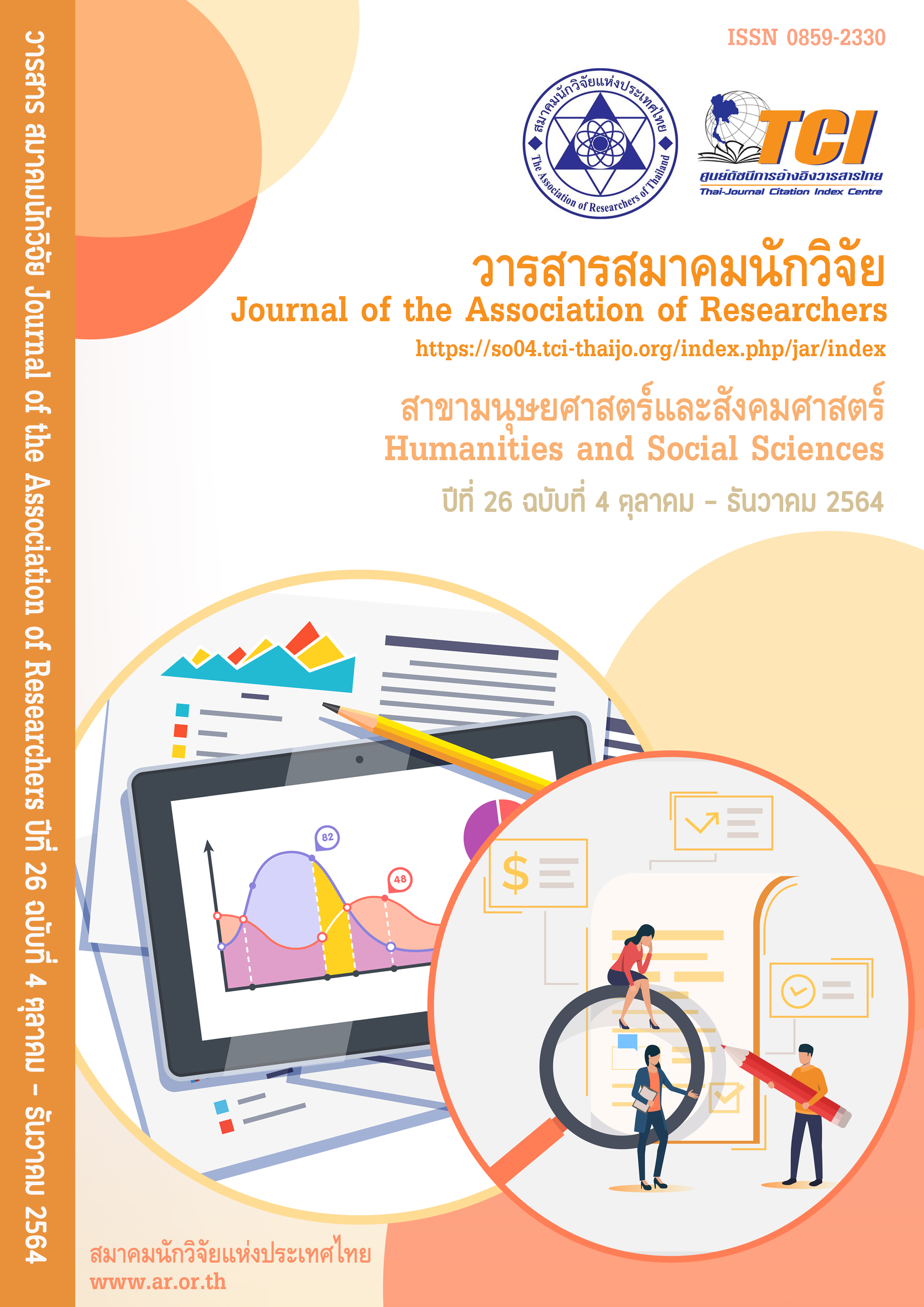Enhancing the congruence of the career interests and career needs of high school students through guidance activities
Main Article Content
Abstract
The purposes of this research are as follows: (1) to study the congruence of career interests and career needs of high school students; and (2) to compare the congruence of career interests and career needs of high school students before and after using guidance activities. The research was divided into two phases. The first phase was to study the congruence of career interests and career needs of students. The samples were 286 students selected by simple random sampling. The second phase was to enhance the congruence of career interests and career needs and 12 samples were selected by purposive sampling methods. These samples were also considered by the results from Phase 1, in which they were incongruent in terms of their career interests, career needs, and with their voluntary and random assignment to participate in this experiment. The instruments used in this research included: (1) Comprehensive screening form of the congruence between career interests and career needs Inventory with a reliability of .96; (2) The S.D.S. (Self-Directed Search) survey; and (3) Guidance activities for enhancing career interests and career needs. The statistics used to analyze the data consisted of percentage, mean, standard deviation of the scores, and a t-test dependent on the sample. The research results were as follows: (1) High school students had 91.6 percent congruence of career interests and career needs, while 8.4 percent of students had incongruence of career interest and career needs.; and (2) after the experiment, the students had higher congruence of career interests and career needs at a statistically significant level of .01
Article Details
บทความที่ปรากฏในวารสารนี้ เป็นความรับผิดชอบของผู้เขียน ซึ่งสมาคมนักวิจัยไม่จำเป็นต้องเห็นด้วยเสมอไป การนำเสนอผลงานวิจัยและบทความในวารสารนี้ไปเผยแพร่สามารถกระทำได้ โดยระบุแหล่งอ้างอิงจาก "วารสารสมาคมนักวิจัย"
References
กรมการจัดหางาน. (2559b). คู่มือการเตรียมความพร้อมก่อนเข้าสู่ตลาดแรงงาน: กระบวนการช่วยให้ผู้รับบริการแนะแนวรู้จักอาชีพ. สืบค้นจากhttps://www.doe.go.th/prd/assets/upload/files/vgnew_th/c827be4dabb6fb454f5c2f1f827d523c.pdf
กัญญาภัทร เสนีวงศ์ ณ อยุธยา. (2557). การมีส่วนร่วมของผู้ปกครองด้านอาชีพ การรับรู้ความสามารถของตนด้านอาชีพและความสอดคล้องในตนด้านเป้าหมายการเลือกอาชีพของนักเรียนมัธยมศึกษาตอนปลาย. (ปริญญานิพนธ์ศิลปศาสตรมหาบัณฑิต). จุฬาลงกรณ์มหาวิทยาลัย, กรุงเทพฯ.
กุลธิดา สีบัวบาน. (2553). ผลการใช้โปรแกรมการฝึกอบรมที่มีต่อกระบวนการตัดสินใจเพื่อเลือก. (ปริญญานิพนธ์ปริญญามหาบัณฑิต). มหาวิทยาลัยศรีนครินทรวิโรฒ, กรุงเทพฯ.
เก็จกาญจน์ กนกแก้ว. (2558). ผลการใช้ชุดกิกจรรมแนะแนวโดยใช้ศิลปะเป็นสื่อส่งเสริมวุฒิภาวะทางอาชีพของนักเรียนชั้นมัธยมศึกษาปีที่ 2 โรงเรียนรัตนบุรี จังหวัดสุรินทร์. (ปริญญานิพนธ์ศึกษาศาสตรมหาบัณฑิต). มหาวิทยาลัยสุโขทัยธรรมาธิราช, นนทบุรี.
จตุพล บุญภิญโญ. (2561). การพัฒนาแบบวัดความสนใจในการทำกิจกรรมเพื่อการแนะแนวอาชีพโดยประยุกต์ทฤษฎีพหุปัญญา สำหรับนักเรียนชั้นมัธยมศึกษาตอนปลาย. (ปริญญานิพนธ์ปริญญามหาบัณฑิต). มหาวิทยาลัยศรีนครินทรวิโรฒ, กรุงเทพฯ.
เจียรนัย ทรงชัยกุล. (2557). เอกสารการสอนชุดวิชาหลักและระบบงานแนะแนวในสถานศึกษา. นนทบุรี: มหาวิทยาลัยสุโขทัยธรรมาธิราช.
ชลลดา พันธุ์เนตร. (2561). การเปรียบเทียบผลของการใช้โปรแกรมกิจกรรมแนะแนวอาชีพตามทฤษฎีของ แฟรงค์ พาสันส์กับทฤษฎีของเกอแลตที่มีต่อความสามารถในการตัดสินใจเลือกอาชีพของนักเรียนระดับชั้นมัธยมศึกษาปีที่ 3. (ปริญญานิพนธ์ปริญญามหาบัณฑิต). มหาวิทยาลัยศรีนครินทรวิโรฒ, กรุงเทพฯ.
ณัฐนันท์ มั่นคง. (2559). ความสัมพันธ์ระหว่างการสำรวจอาชีพและความแน่ใจทางอาชีพในนักเรียนมัธยมศึกษาตอนปลายโดยมีอุปสรรคในการตัดสินใจเกี่ยวกับอาชีพเป็นตัวแปรควบคุม.
(ปริญญาศิลปศาสตรมหาบัณฑิต). จุฬาลงกรณ์มหาวิทยาลัย, กรุงเทพฯ.
ทิศนา แขมมณี. (2545). กลุ่มสัมพันธ์เพื่อการทำงานและการจัดการเรียนการสอน. กรุงเทพมหานคร:
นิชินแอดเวอร์ไทซิ่ง กรูฟ.
นวลศิริ เปาโรหิตย์. (2534). แบบทดสอบ S.D.S (Self Directed Search). กรุงเทพมหานคร: สมาคมแนะแนวแห่งประเทศไทย
ปิยะนันท์ คงไพ่. (2561). ระบบแนะนำการเลือกอาชีพตามทฤษฎีของจอห์น ฮอลแลนด์ ที่ได้จากการวิเคราะห์ด้วยวิธีต้นไม้ตัดสินใจ. (ปรัชญาดุษฎีบัณฑิต). บัณฑิตวิทยาลัย. มหาวิทยาลัยเทคโนโลยีพระจอมเกล้าพระนครเหนือ, กรุงเทพฯ.
รภัทกร ทัศนโชติเดชา. (2553). ปัจจัยที่มีอิทธิพลต่อการตัดสินใจเลือกอาชีพของนักศึกษาระดับประกาศนียบัตรวิชาชีพชั้นสูงชั้นปีที่ 2 วิทยาลัยอาชีวศึกษาสระบุรี. (หลักสูตรพัฒนาแรงงานและสวัสดิการมหาบัณฑิต). มหาวิทยาลัยธรรมศาสตร์, กรุงเทพฯ.
วิภาวดี ปัจจัยโก. (2544). ปัจจัยบางประการที่ส่งผลต่อความสนใจในอาชีพทางวิทยาศาสตร์และเทคโนโลยี ของนักเรียนชั้นมัธยมศึกษาปีที่ 3. (ปริญญานิพนธ์ปริญญามหาบัณฑิต).
มหาวิทยาลัยศรีนครินทรวิโรฒ, กรุงเทพฯ.
สกล วรเจริญศรี. (2558). การแนะแนวเพื่อการพัฒนาคุณค่าแห่งตน จากแนวคิด ทฤษฎีสู่การปฏิบัติเพื่อการพัฒนาผู้เรียน (พิมพ์ครั้งที่ 2). กรุงเทพฯ: ส. วรเจริญศรี.
สมคิด กอมณี. (2559 กรกฎาคม – ธันวาคม). รูปแบบการแนะแนวอาชีพสำหรับนักเรียนในระดับชั้นมัธยมศึกษา. วารสารวิชาการศึกษาศาสตร์. คณะศึกษาศาสตร์ มหาวิทยาลัยศรีนครินทรวิโรฒ, 17(2), 106-122.
สุธาสินี สัตย์เจริญ. (2561). ผลของการใช้โปรแกรมการเรียนรู้แบบนำตนเองที่มีต่อการตัดสินใจเลือกอาชีพของนักเรียนชั้นมัธยมศึกษาปีที่ 4. (ปริญญานิพนธ์ปริญญามหาบัณฑิต).
มหาวิทยาลัยศรีนครินทรวิโรฒ, กรุงเทพฯ.
หนึ่งฤทัย กูระเสถียร. (2548). การสร้างชุดการสอนกิจกรรมแนะแนวเพื่อพัฒนาด้านการศึกษาและอาชีพของนักเรียนช่วงชั้นที่ 4. (ปริญญานิพนธ์ปริญญามหาบัณฑิต). มหาวิทยาลัยศรีนครินทรวิโรฒ, กรุงเทพฯ.
อำนาจ สุวรรณสอาด. (2549). ความสัมพันธ์ระหว่างบุคลิกภาพกับความต้องการประกอบอาชีพอิสระของ
นักศึกษา วิทยาลัยเทคนิคราชบุรี. (ปริญญานิพนธ์ปริญญามหาบัณฑิต).
มหาวิทยาลัยศรีนครินทรวิโรฒ, กรุงเทพฯ.
Holland, J. L. (1996). The psychology of Vocational Choice. New York: Blaisdell Publishing Company.
Translated Thai References
Boonpinyo, C. (2018). A Development of the interest test in activities for career guidance
by applying theory of multiple intelligences for senior high school students. (Master degree). Srinakharinwirot University, Bangkok.
Department of Employment. (2016b). Handbook of preparation before entering the labor market: the process of helping Recipients of career guidance services. Retrieved from https://www.doe.go.th/prd/assets/upload/files/vgnew_th/c827be4dabb6fb454f5c2f1f 827d523c.pdf
Kanokkaew, K. (2015). The effect of using a guidance activities package with the use
of arts as media to enhance career maturity. of Mathayom suksa 2, students at Rattana Buri School in Surin Province. (Master of Education Thesis). Sukhothai Thammathirat Open University, Nonthaburi.
Khamanee, T. (2002). Relationships for Work and Teaching Management. Bangkok: Nichin Advertising Groove.
Khongphai, P. (2018). Career Advisory System based-on John Holland Theory using
Decision Tree. (Doctor of Philosophy). Graduate School. King Mongkut's University of Technology North Bangkok, Bangkok.
Kommanee, S. (2016 July-December). Model of career guidance for students
in Mattyomsuksa schools. Journal of Education. Faculty of Education Srinakharinwirot University, 17(2), 106-122.
Kurasathien, N (2005). Constructing a guidance activity teaching package to develop education and career of fourth level secondary students. (Master degree). Srinakharinwirot University, Bangkok.
Monkong, N. (2016). The Relation of career exploration and certainty among high school students; Using career decision-making difficulties as controls. (Degree of Master of Arts). Chulalongkorn University, Bangkok.
Pannet, C. (2018). Comparison of the using a career guidance activity program by applying the theories of parson and Gelatt Influencing the career decision making abilities of Mattayomsuksa 3 students. (Master degree). Srinakharinwirot University, Bangkok.
Paorohit, N. (1991). S.D.S test (Self Directed Search). Bangkok: The Guidance Association of Thailand.
Patjaigo, W. (2001). Some factors contributed to interest in science and technology careers of Mathayom suksa students in Grade 3. (Master degree). Srinakharinwirot University, Bangkok.
Seebuaban, K. (2010). The effect of training on career decision-making.(Master degree). Srinakharinwirot University, Bangkok.
Seneewong Na Ayudhaya, K. (2014). Parental career-specific involvement, Career
self-Efficacy, And self-concordance in career-related goals among high school student. (Master of Arts Thesis). Chulalongkorn University, Bangkok.
Songchaikul, C. (2014). Documents for teaching the main courses and the guidance system
in educational institutions. Nonthaburi: Sukhothai Thammathirat Open University.
Sutcharoen, S. (2018). Effects of Self-Directed learning program on Career
Decision-Making among Matthayomsuksa 4 students. (Master degree). Srinakharinwirot University, Bangkok.
Suwansa-ard, A. (2006). Relationship between personality and self-employed needs
of students of Ratchaburi Technical College. (Master degree). Srinakharinwirot University, Bangkok.
Tassanachotdecha, R. (2010). Factors the Influencing Decision of Second-year Vocational College in Changwat Saraburi to choose careers. (Labor development course and Master's Welfare). Thammasat University, Bangkok.
Voracharoensri, S. (2015). Guidance for self - esteem development : from concept, theory to practice for learner development. (2nd edition). Bangkok: S. Woracharoensri.


